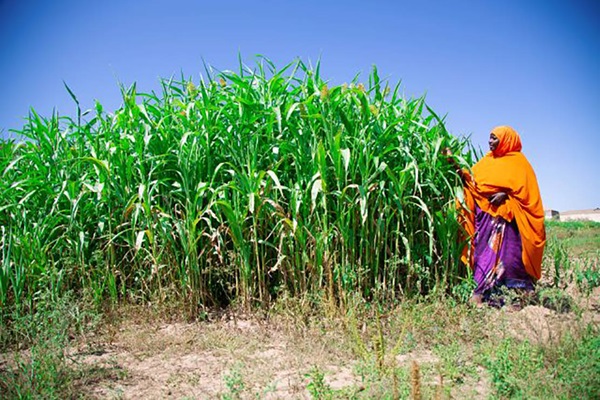
Desert locust crisis (2020–2021)
With the tremendous support of resource partners, FAO has made great strides against the worst desert locust upsurge to hit the Greater Horn of Africa and Yemen in decades. Now, we can finally say that the upsurge has come to an end.
Timely and generous contributions amounting to USD 230.5 million between January 2020 and December 2021 enabled FAO – working closely with governments and partners – to put in place and maintain an extraordinarily effective system capable of forecasting, coordinating and responding in order to keep desert locust at bay as well as prepare for future upsurges.
The sixth and final “Progress report on the response in the Greater Horn of Africa and Yemen” details the work carried out by FAO across the region between September and December 2021 to combat the upsurge’s unprecedented threat to food security and livelihoods, while providing an overview of the outcomes of the response in all of 2021.
FAO’s fully funded appeal allowed for the treatment of nearly 2.3 million ha of desert locust-infested land in targeted countries, through ground and aerial operations between January 2020 and December 2021. These efforts averted 4.5 million tonnes of crop losses, saved 900 million litres of milk production, and secured food for 41.5 million people. The commercial value of the cereal and milk losses averted through the response is estimated at USD 1.77 billion.
The devastating impact of the upsurge on livelihoods was in turn mitigated through a combination of in-kind and/or cash support; over 305 000 households were supported by FAO and an additional 300 000 by non-governmental organizations, providing approximately 3 million people with the means to meet their immediate needs and to restore their productive capacity.
FAO's Desert Locust Information Service (DLIS) provided timely and accurate early warning and forecasts throughout the upsurge. Collaboration with academic, research and private sector partners resulted in 16 new innovations that have been integrated into DLIS and national locust programmes to further improve monitoring and early warning, including important tools such as the eLocust3 application – used to record field observations and transmit them in real time via satellite to inform the response.
Finally, important developments were made in the effort to safeguard environmental and human health – particularly against the impact of pesticides – at the intersection between desert locust response and the One Health approach. Biopesticides and insect growth regulators were used when possible as environmentally friendly alternatives to conventional pesticides that can help to contribute towards the sustainability of the ecosystem. By carefully controlling the entire pesticide lifecycle during control operations, providing guidance in the form of an Environment, Health and Safety Standards Manual for the region and designing a Locust Pesticide Management System, FAO helped to reduce the risks associated with pesticides in control campaigns, promote early response to outbreaks and upsurges and encourage cooperation for preventive control among locust-affected countries.While we can now state that this historic upsurge has been defeated, challenges remain to maintain the gains made over the past two years and ensure countries can sustain the robust monitoring and control systems that have been put into place, improving the region’s collective ability to prevent future upsurges and plagues. FAO will continue to work diligently with high-risk countries to keep surveillance and response mechanisms intact to bolster our collective efforts against this ancient pest.
Latest news
.tmb-th600x400.jpg?Culture=en&sfvrsn=20f97bf8_6)
News
FAO Desert Locust campaign: East Africa upsurge suppressed, Kenya free from Desert Locust
15/06/2022
Interview with Cyril Ferrand, FAO’s Resilience Team Leader for East Africa, and Carla Mucavi, FAO Country Representative in Kenya

News
Overcoming impacts of desert locusts, drought and displacement through climate-smart agriculture practices in Somaliland
06/01/2022
FAO’s desert locust response programme is supporting rural farming households to address acute food insecurity in rural areas while contributing to...

News
Horn of Africa: “We want to prevent as many people as possible from having to rely solely on food assistance”
25/11/2021
Interview with Carla Mucavi, FAO Representative in Kenya
Key documents

The 2020–2021 desert locust upsurge: How anticipatory action prevented a full blown humanitarian crisis
05/2022
In late 2019, a massive outbreak of desert locusts swept across the greater Horn of Africa and Yemen. This infographic outlines the actions FAO and partners took to avert a disaster, and showcases the impacts and results of the early, scaled up action.

Desert locust upsurge: Progress report on the response in the Greater Horn of Africa and Yemen, September–December 2021
05/2022
This sixth and final progress report details FAO’s work to mitigate the effects of the desert locust upsurge – an unprecedented threat to food security and livelihoods – across the Greater Horn of Africa and Yemen between September and December 2021, while outlining the outcomes of the response in all of 2021.
Multimedia

Interactive story
Meet the world's most destructive migratory pest
Desert locusts pose a major threat to food security and livelihoods.
FAO East Africa: The Battle Against Locust
22/09/2021
East Africa has scored big wins in its battle against the largest invasion of locust in living memory: more than 2 million hectares of land surveyed...
Video
East Africa and Yemen region free from Desert Locust
23/06/2022
Starting in late 2019, the largest upsurge of desert locusts in living memory darkened the skies of East Africa and Yemen, threatening to wipe out crops...
